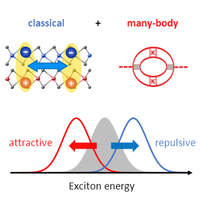Exciton-Exciton Interactions in Van der Waals Heterobilayers
IF 11.6
1区 物理与天体物理
Q1 PHYSICS, MULTIDISCIPLINARY
引用次数: 0
Abstract
Exciton-exciton interactions are key to understanding nonlinear optical and transport phenomena in van der Waals heterobilayers, which emerged as versatile platforms to study correlated electronic states. We present a combined theory-experiment study of excitonic many-body effects based on first-principle band structures and Coulomb interaction matrix elements. Key to our approach is the explicit treatment of the fermionic substructure of excitons and dynamical screening effects for density-induced energy renormalization and dissipation. We demonstrate that dipolar blueshifts are almost perfectly compensated by many-body effects, mainly by screening-induced self-energy corrections. Moreover, we identify a crossover between attractive and repulsive behavior at elevated exciton densities. Theoretical findings are supported by experimental studies of spectrally narrow, mobile interlayer excitons in atomically reconstructed, -BN-encapsulated heterobilayers. Both theory and experiment show energy renormalization on a scale of a few meV even for high injection densities in the vicinity of the Mott transition. Our results revise the established picture of dipolar repulsion dominating exciton-exciton interactions in van der Waals heterostructures and open up opportunities for their external design.

范德华杂硅层中的激子-激子相互作用
激子-外激子相互作用是理解范德华杂硅层中非线性光学和传输现象的关键,范德华杂硅层是研究相关电子态的多功能平台。我们基于第一原理能带结构和库仑相互作用矩阵元素,对激子多体效应进行了理论与实验相结合的研究。我们研究方法的关键是明确处理激子的费米子子结构以及密度诱导的能量重正化和耗散的动态筛选效应。我们证明,双极性蓝移几乎可以通过多体效应(主要是筛选诱导的自能修正)得到完美补偿。此外,我们还发现在激子密度升高时,吸引力和排斥力行为之间存在交叉。对原子重构、氢化萘封装的 MoSe2/WSe2 异质层中光谱狭窄、可移动的层间激子进行的实验研究支持了理论发现。理论和实验都表明,即使在莫特转换附近的高注入密度下,能量重正化的尺度也只有几 meV。我们的研究结果修正了范德华异质结构中双极性斥力主导激子-激子相互作用的既定图景,并为其外部设计提供了机会。
本文章由计算机程序翻译,如有差异,请以英文原文为准。
求助全文
约1分钟内获得全文
求助全文
来源期刊

Physical Review X
PHYSICS, MULTIDISCIPLINARY-
CiteScore
24.60
自引率
1.60%
发文量
197
审稿时长
3 months
期刊介绍:
Physical Review X (PRX) stands as an exclusively online, fully open-access journal, emphasizing innovation, quality, and enduring impact in the scientific content it disseminates. Devoted to showcasing a curated selection of papers from pure, applied, and interdisciplinary physics, PRX aims to feature work with the potential to shape current and future research while leaving a lasting and profound impact in their respective fields. Encompassing the entire spectrum of physics subject areas, PRX places a special focus on groundbreaking interdisciplinary research with broad-reaching influence.
 求助内容:
求助内容: 应助结果提醒方式:
应助结果提醒方式:


